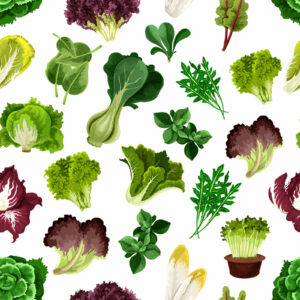
4 Super Leafy Greens for Improved Eyesight
It’s a well-known old wives’ tale that spinach can help your eyesight. Our mothers and our mother’s mothers before that told us to eat our vegetables. As it turns out, what our moms have been telling us for years isn’t an old wives’ tale at all. Spinach, along with other leafy greens, has been scientifically proven to help improve our eyesight. A healthy inclusion of spinach, watercress, kale, and arugula could be the difference between poor and good eyesight.
 That being said, we know leafy greens don’t sound enticing to some people. What else can you do with them besides make a salad or top a burger? Well, today we won’t just be going over how these leafy greens help our eyesight. We’ll also give you some interesting ways to add them to your diet!
That being said, we know leafy greens don’t sound enticing to some people. What else can you do with them besides make a salad or top a burger? Well, today we won’t just be going over how these leafy greens help our eyesight. We’ll also give you some interesting ways to add them to your diet!
1. Spinach
Spinach is the ultimate leafy green when it comes to improving eyesight. The small leaf is packed with lutein and zeaxanthin, which are healthy antioxidants your eyes and body need.
These antioxidants help to prevent free radicals in the eyes. When free radicals are present, they lead the cells in your eyes to die off. They can leave you open to various vision conditions and diseases.
One disease that spinach helps to prevent is macular degeneration. Macular degeneration is a disease that affects the macula of the eye, which is found at the center of the retina. It is the leading cause of blindness in older adults.
When the macula begins to degenerate, it will slowly diminish a person’s central vision. Though the macula will eventually degenerate, foods like spinach help to keep the disease at bay.
Spinach and Peanut Butter Smoothie
Spinach doesn’t have to be a boring food that Popeye used to gain muscle. And, it doesn’t have to be used in a plain old salad. One of the best ways to incorporate it into your diet is to blend it into a green smoothie.
What you’ll need:
- One banana
- One cup of your favorite type of milk
- One tablespoon of peanut butter
- A handful of spinach
- Ice cubes
Combine these ingredients into a blender and pulse until it reaches the consistency you like. Add less ice for a more liquid smoothie and more ice for something a little denser. This recipe makes one serving.
If peanut butter isn’t your cup of tea, feel free to use tahini or another nut-free substitute.
2. Watercress
Watercress are those small leafy greens you get as a garnish at restaurants and wonder if you’re supposed to eat them. Most of the time, they get tossed aside because people don’t understand the health benefits they present.
Watercress comes from the same family as kale and arugula, our last two greens on the list. This tiny green is full of eye-healthy vitamins A, B6, B12, C, K, iron, calcium, magnesium, and lutein and zeaxanthin.
In fact, watercress has more calcium and more vitamin C than milk and oranges, respectively. However, you’d need to eat an orange’s weight in watercress to get the benefits. That is unreasonable, but it doesn’t mean that the nutrients found in watercress are not beneficial.
Watercress can also help prevent cataracts. The amount of vitamin A found in watercress can help fight free radicals which cause cataracts. Cataracts are the forming of a protein buildup on the lens of the eye. Like macular degeneration, cataracts also affect a person’s central vision.
Watercress Pesto
Basil has long been the reigning king of pesto, the classic Italian pasta topping. However, watercress makes a pretty mean pesto, too. Here’s what you’ll need:
- One bunch of watercress (hard stems removed)
- Two tablespoons of pine nuts
- Two tablespoons of olive oil
- Salt
Add the watercress and pine nuts to a food processor. Once coarsely chopped, gradually add the olive oil and pulse until smooth. Then add salt and blend one more time. Serve the pesto on sandwiches or with your favorite type of pasta.
(Recipe from marthastewart.com)
3. Kale
Kale has recently experienced a spike in popularity as it appears on every health blog and cooking website. People are finding endless ways to eat kale because it is a leafy green superfood.
Kale is best known for its vitamin A content. Just half a cup of it will get you to your daily recommended allowance of vitamin A for the day. Along with vitamin A, kale also has vitamin B, beta-carotene, calcium, potassium, and iron.
Kale’s nutrients strengthen our retinas. The retina is the part of the eye that allows us to perceive light, shadows, and colors. The retina needs a high amount of vitamin A and beta-carotene to stay healthy. Kale will also help to keep the blood cells in the eyes healthy and prevent blockages or leaking.
Kale Chips
Have a craving for something salty and crispy? You may want to hold off on the potato chips and try these kale chips instead. They’re just as delicious but 10 times healthier. Here’s what you’ll need:
- One bunch of kale
- Salt
- One tablespoon of salt
Start with preheating your oven to 350 degrees. Cut the leaves off of the stems and tear them into bite sized pieces. Spread the kale evenly on a baking sheet lined with parchment paper. Drizzle it with the olive oil and sprinkle it with salt. Then bake for 10 to 15 minutes.
(Recipe from allrecipes.com)
4. Arugula
Arugula is a leafy green often used in Italian cooking. It adds a uniquely nutty taste that will elevate any dish from bland to sophisticated. Arugula contains carotenoids, vitamins A and B, calcium, iron, and potassium.
Because arugula contains a large amount of carotenoids, it helps the body absorb nutrients. The same goes for the eyes. Arugula will help your eyes absorb the proper nutrients they need to stay healthy and improve your eyesight.
Arugula Pizza
We may be cheating with this one because it requires no cooking. We know it can be hard to resist a good slice of pizza. Though it isn’t the healthiest choice of food, you can make it a little heartier by topping it with some arugula.
Wash your arugula leaves and dry them with a paper towel or with a lettuce spinner. Then top your favorite pizza with a handful!
Tip: you can also top pasta with arugula. It will add a nice pop of veggie to a dish otherwise void of them.
Leafy greens are superheroes to your eyes. They prevent disease and ensure your eyes get the nutrients they need. Focus on incorporating the four greens above into your diet. Try the receipts listed or find your own. The options for healthy green dishes are endless!
Our Rebuild Your Vision Ocu-Plus Formula Contains All 17 Vitamins, Minerals, and Herbal Supplements to Improve Your Eye Health!












Are you supposed to cook spinach and kale?
Anna
There are lots of supergreens without any actual health benefit testimonials. Are these really successfully improved eye health? Eliminated any sort of illness? There are too much blahs without actual result.
Thank you for the information though I haven’t tried it , but it’s definitely worth trying my eye is been bothering me.